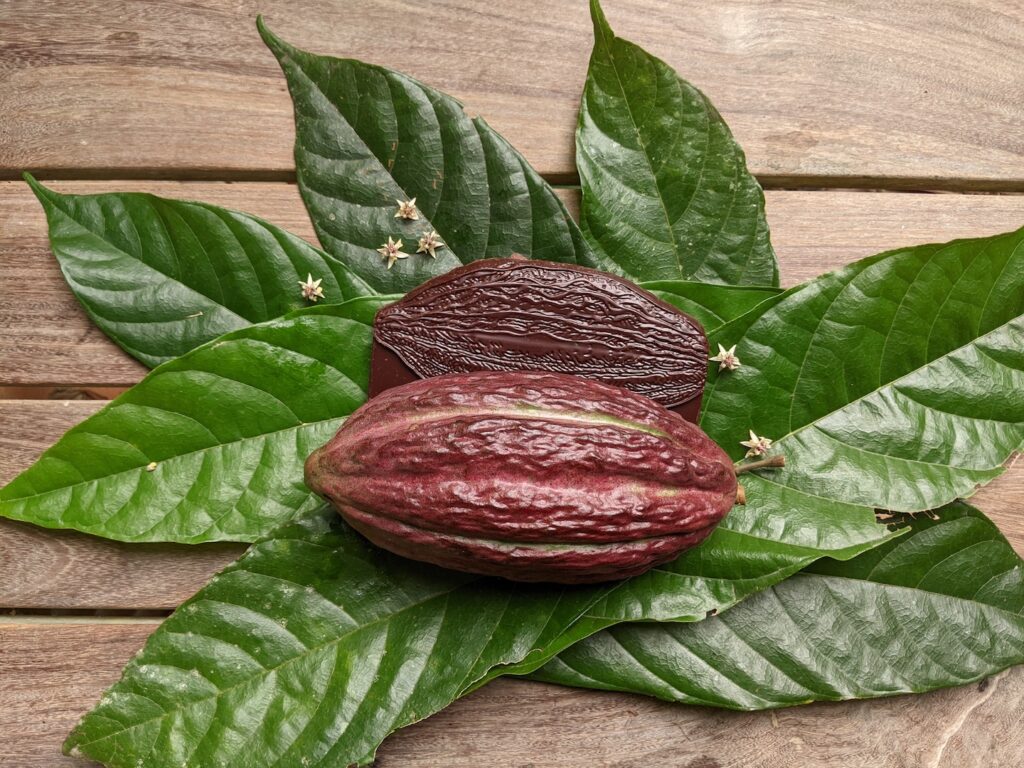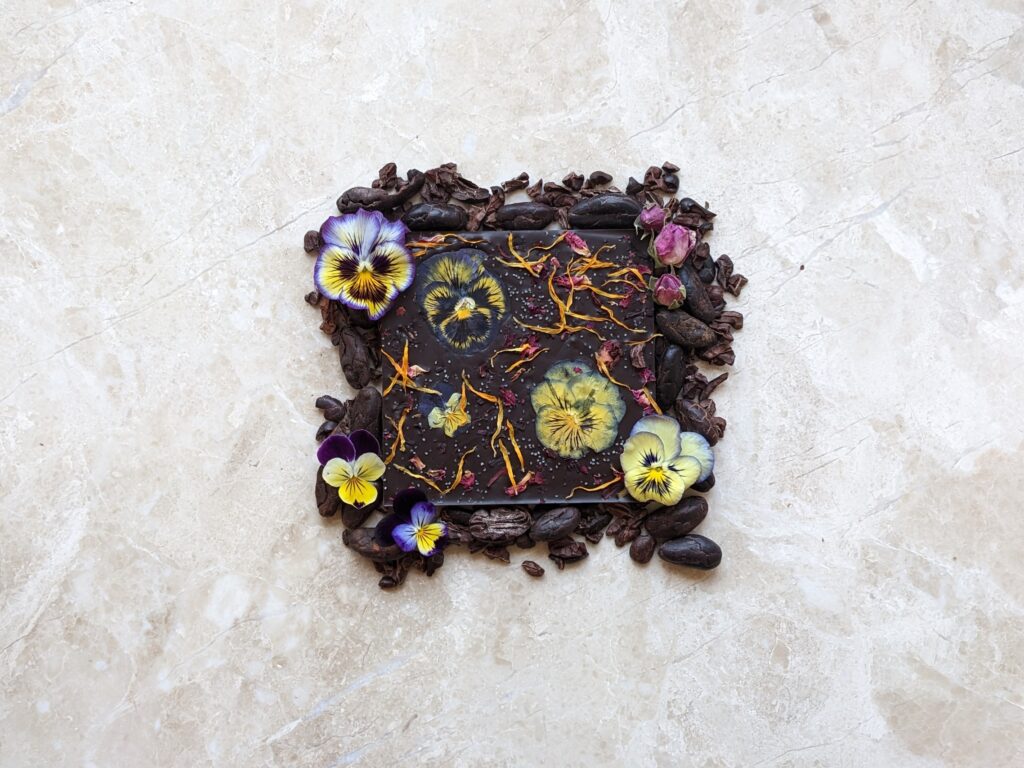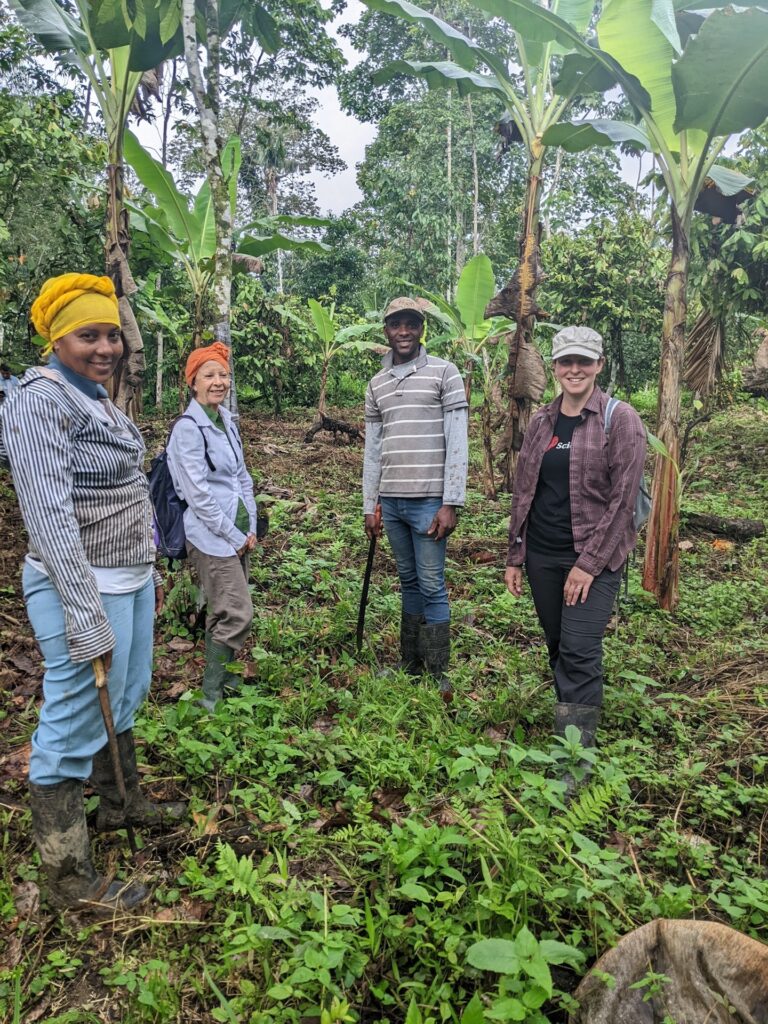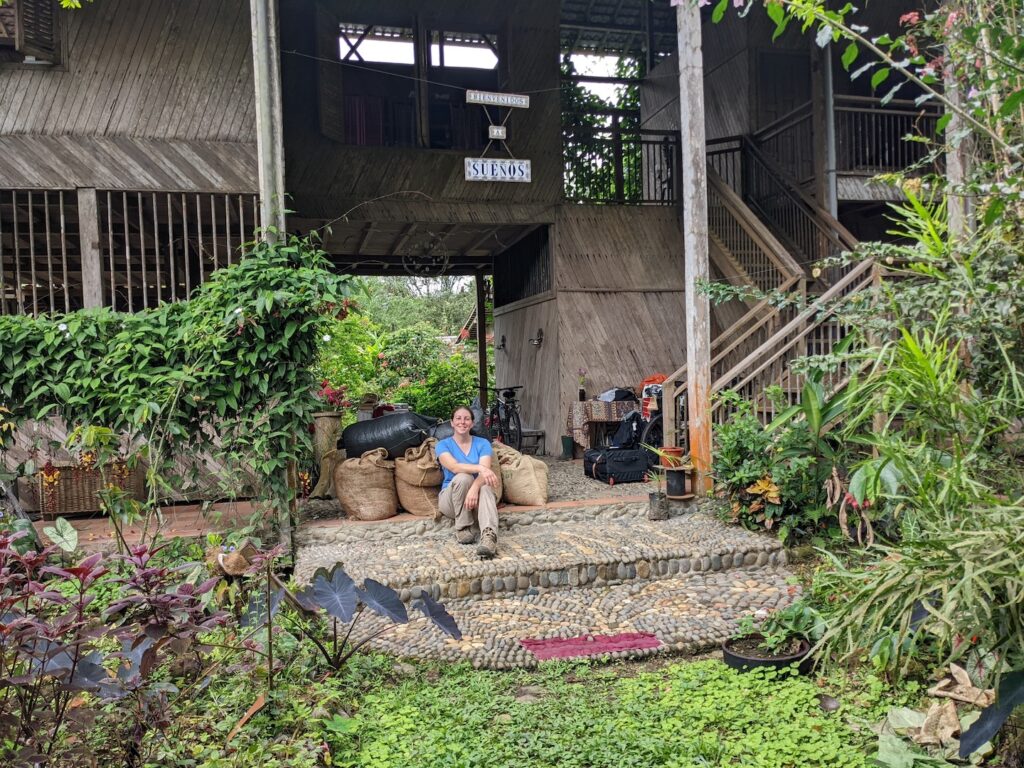Most corners of this industry are pretty dark, though there are glimmers of hope for change. For chocolate lovers with a conscience, it’s a matter of knowing where to look — and what to look for.
Karen, my Guatemalan friend, had a gift for me — a disc of chocolate she’d brought me from her country. “It’s for hot chocolate,” she said, guiding me through how to make the traditional chocolate drink she’d grown up with. “Chocolate in Guatemala is not considered candy,” she explained. “We drink it more than eat it.” Chocolate is a big part of Guatemalan culture, Karen told me. “Cacao beans were used as currency by the Mayans, so it has always been considered valuable.” Even now, it plays a role in religious and cultural ceremonies like Christmas or First Communion. “It’s as important as coffee. We are always offered both.”
Following Karen’s instructions, I melted the chocolate in a pan with water and poured the mixture into a mug. I took a sip and was struck by its bitterness.
In point of fact, the consumption of sweetened chocolate is only a few centuries old, whereas for many centuries — maybe even millennia — chocolate was consumed principally as a bitter, yet coveted, beverage — the way it’s still typically enjoyed in Guatemala. The Mayans and Aztecs drank chocolate during marriages, sacrifices, and other important ceremonies, convinced of its magical properties. And, as Karen told me, chocolate was so valuable to them that they even used the beans as currency.
But though modern chocolate is sweeter than it once was, it retains a bitter pedigree. Although it’s an economic engine in a few parts of the world, its profits rarely benefit the people who perform the hard labor of growing and picking the cocoa beans from which chocolate is made.
It’s been years since we learned about chocolate’s dark side — that much of the cocoa we consume is produced largely by the slave labor of children in Africa’s Ivory Coast and Ghana. Citizens and advocacy groups called out the companies buying cocoa produced in this way, and those companies issued pledges to address the concern. Certification programs were announced — Fairtrade, Rainforest Alliance, UTZ — and U.S. politicians pressured the industry to tackle the issue. In an article for a 2016 issue of Fortune, reporter Brian O’Keefe wrote that “former Sen. Tom Harkin, a Democrat of Iowa, and Rep. Eliot Engel, a New York Democrat, pushed the big chocolate makers to agree to eradicating the worst forms of child labor, as defined by the International Labor Organization’s Convention No. 182, by July 1, 2005.” However, a 2019 story in the Washington Post noted that “the world’s chocolate companies have missed deadlines to uproot child labor from their cocoa supply chains in 2005, 2008, and 2010. Next year [2020], they face another target date and, industry officials indicate, they probably will miss that, too.”
Spoiler: They did.
Meanwhile, the world’s hunger for chocolate continues to grow, even as children, some as young as five or six years old, remain in the fields, harvesting cocoa with machetes, and farmers growing cocoa remain so impoverished that they couldn’t afford to buy the chocolate they help produce.
Danish filmmaker Miki Mistrati just wanted to buy himself a chocolate bar in 2001, when he noticed that one out of the seven available chocolate bars at his local store was marked “Fairtrade.” He asked himself a question that would change his life: Were the other six unfair trade?
Mistrati hooked up with a photographer who’d been investigating child slavery for Fortune magazine, and the two set off for Mali. “I was just sitting in a bus stop in the southern part of the country,” Mistrati recently told podcaster Jordan Harbinger, “and some local helpers told me, ‘Hey, you just wait for the next bus and you will see that kids — you know, six, eight, ten years old — are getting picked up by traffickers.’ And they literally just did that in front of my face.”
That was more than twenty years ago, back when the truth about cocoa production was just coming to light. It led to Mistrati’s first film, The Dark Side of Chocolate. Since then, he’s kept tabs on the chocolate industry of the Ivory Coast in Africa, where two thirds of the world’s cocoa is grown, and not much has changed.
“At that time, when I did my first film, they said, ‘Oh my goodness, we didn’t know there was a problem,’” Mistrati told podcaster Harbinger. “Well, today they are more like, ‘Well, we know there is a problem and we are doing our best to stop this,’ which is bollocks in my opinion. Because if you wanted to stop this, it would be so easy.”
Kerry Daroci, the Cocoa Sector Lead with Rainforest Alliance, doesn’t believe it’s that simple. Daroci has spent close to a decade investigating chocolate in order to help determine who earns the Rainforest Alliance certification, denoting that the chocolate within the wrapper “was produced using methods that support the three pillars of sustainability: social, economic, and environmental,” according to the organization’s site.
Rainforest Alliance is a well-known certification program, reliant on third-party verification, meaning that those determining which cocoa providers subscribe to the Rainforest Alliance’s principles are independent of the organization and industry itself.

Nonetheless, the Sierra Club recently criticized cocoa fairness certification, noting that “Well-known certifiers, such as Fairtrade International and Rainforest Alliance/UTZ Certifiers, are only required to visit fewer than ten percent of cocoa farms. And they don’t do surprise visits.”
Rainforest Alliance responded to these allegations, both to Sierra Club and Bluedot, noting that the information Sierra Club referenced dates back to 2019, prior to the launch of the Rainforest Alliance’s significantly strengthened Certification Program and Cocoa Assurance Plan. “After a multi-phased rollout and implementation,” a spokesperson for the organization wrote, “this plan has greatly strengthened our work in the cocoa sector of West Africa, and the Rainforest Alliance continues to build on these improvements.”
But change doesn’t come easily in the cocoa industry. As Rainforest Alliance’s Daroci says, “it’s been estimated that cocoa farmers receive about six percent of chocolate bars’ retail price, on average. … They’re clearly on the losing end of a very long, complicated supply chain.”
What’s more, climate change is making an already challenging crop even more challenging. In early 2024, cocoa futures hit a record high as particularly rainy weather in West Africa’s Ivory Coast and Ghana — where 60 percent of the world’s cocoa is produced — led much of the cocoa crop to spoil due to rot and disease. Farmers are being forced to decide between moving their cocoa farms uphill or quitting altogether. According to Daroci, two interconnected issues — climate change and poverty — drive the sector-wide problems of deforestation and child labor.
Daroci finds hope in what she says is “more public conversation” about these issues, but has that translated into actual change on West African cocoa farms?
Miki Mistrati offers an emphatic no, and indeed, a 2019 Washington Post story cites a U.S. Department of Labor survey that put the number of child laborers on cocoa farms at two million.
Which is why International Rights Advocates (IRA), a Washington, D.C.-based human rights firm, is speaking in a language that corporations understand. On February 12, 2021, the firm filed a lawsuit against Nestlé, U.S.A.; Cargill, Incorporated; Cargill Cocoa; Barry Callebaut USA LLC; Mars, Incorporated; Mars Wrigley Confectionery; Olam Americas, Inc.; the Hershey Company; and Mondelēz International, alleging violations of International Labor Organization Convention No. 182 (Worst Forms of Child Labor) on behalf of eight plaintiffs who were trafficked as children from Mali to the Ivory Coast. Terry Collingsworth, a U.S. human rights lawyer and lead counsel for IRA wants consumers to know that companies are lying about what they’re doing. “The cocoa companies … promised twenty years ago … they would stop profiting from child labor,” he told WBUR host Deepa Fernandes in December 2023. “But it’s worse than ever.”
CBS News ran a story in late November, 2023, for which reporters drove up to plantations and found children as young as five years old at work wielding machetes, including children who, according to cocoa companies’ data, were ostensibly in school.
The root problem is poverty, Daroci insists, often driving farmers to put their children to work on the farms. Most farmers don’t want their children working on a cocoa farm in dangerous conditions, she says, but “They don’t have other options.”
Deborah Patta, the CBS reporter who found the children on the plantations, wholeheartedly agrees. Farmers simply need to be paid more, she insists.
These farmers were doing what everyone said farmers should be doing, but they were having trouble selling their product at reasonable rates. “And so I learned to make chocolate so I can import their cacao at a [fair] price.”
– Lori Shapiro, Sueños Chocolate
Rainforest Alliance and others look at the ILO definition of “the worst forms of child labor,” in an attempt to focus on the worst offenders and the trafficking. Daroci says that they want to “ensure that children have access to schooling, that they’re not working during times when they should be in school, that they’re not carrying heavy loads, or using machetes or other machinery that can be dangerous for them, spraying pesticides … that could have negative health impact, especially on a growing body.”
She admits that “it’s a very difficult issue to identify and to address.” Rainforest Alliance has created its “assess and address” approach, requiring farmers who want their certification to meet certain conditions monitored by investigators, including ensuring access for children to a school that is reasonably close, and assessing risks to children on farms. It’s a new approach, she says, based on the recognition that simply demanding that farmers don’t use child labor just leads to the practice being more hidden. With this new system in place, Daroci says, “it’s much more likely to bring the issue out in the open and provide solutions.” Rainforest Alliance sees itself as a partner with these farmers, creating “a more well managed, climate smart, productive farm.”
Companies, Daroci says, need to invest in projects that put kids back in school, and that address deforestation. “Having that overall investment is critical,” she says. While she acknowledges that there’s plenty of skepticism about any initiatives by these big chocolate brands, she sees reason for optimism. For instance, Nestle, she says, is undertaking what it calls an Income Accelerator Program, which purports to help farmers diversify so that they’re less reliant on cocoa, as well as adopt a regenerative farming model that’s better environmentally. Hershey, taking its cue from Nestle, has adopted the same model.
Miki Mistrati doesn’t buy it. In his most recent film, The Chocolate War, he went looking for the schools that chocolate companies claimed to be building for child laborers. When the companies themselves refused to give him a list of the schools, he again went undercover. “We did find schools,” he told podcaster Harbinger, “not even half done. The guy running the school said, ‘Well, yeah, they came, and we were doing the plans, and they did the first foundation of the school, and then they disappeared and never came back.’ … it was, again, just greenwashing.”
Even so-called “sustainable cocoa” can’t be relied on, Mistrati said. Instead of claims on chocolate wrappers, Mistrati looks for information on where the chocolate originated. “I buy chocolate from Ecuador or from Peru or South America,” he says.

That’s exactly what Kyleen Keenan, a vegan chef and founder of Happyist Plant-based Foods, did. The Edgartown-based co-author of Chocolate Every Day (and the former proprietor of “Not Your Sugar Mamas” chocolate, which she has since shuttered) told us that because she believes raw cacao is a superfood, abandoning it was not an option for her. Instead she dedicated herself to finding a supplier she could trust to be growing the beans in a way that didn’t harm the environment and that didn’t exploit workers. And that, she says, tasted good.
Her search led her to partner with a co-operative of 164 family farmers in Satipo, Peru, the basin of the Amazon. “We looked for direct trade,” she says, “because we want complete transparency on who we’re buying from and their practices.” The cocoa there is regeneratively farmed from heirloom trees, she explains, making it “probably the most nutrient dense cacao available.” Workers are paid above fair trade prices, a cost reflected, she says, in what she pays for cocoa.
Boston-based chocolatier Lori Shapiro created her company, Sueños Chocolates, to support the farm — Finca Sueños — where she worked during a college exchange program. Shapiro saw firsthand that Finca Sueños’ owner, Yamile Roldan, was “growing these older [cacao] varieties in these very sustainable settings — agroforestry settings … on a small family farm.” But many of the local, small-scale farmers don’t even have cars or trucks to get their product to market, she says, “so farmers are vulnerable to buyers, they don’t have a choice who to sell to. And so they’re really at the mercy of these very influential Latino multinationals that only care about price.” These farmers, she says, were doing what everyone said farmers should be doing, but they were having trouble selling their product at reasonable rates. “And so I learned to make chocolate so I can import their cacao at a [fair] price.”


Farmers like these are, increasingly, joining cooperatives, which better empowers them to demand fair pricing. Finco Sueños, for instance, is now part of Asociación Nueva Esperanza, an organic growers association in Puerto Quito, Pichincha, Ecuador.
The region — and the farming — is not without issues. Kyleen Keenan went there herself when she was seeking farmers from whom to buy raw cacao. “I was hoping to go there and be like, ‘Oh my gosh, everybody’s doing such a great job protecting the rainforest.’ And that was not the truth that I found.” Instead, she says, there’s “deforestation, midnight logging, murders, and everything that goes along with climate awareness is super corrupt. … But I see that the other crops in that region are more part of the problem than cacao.”
The cooperative that she works with (she won’t disclose the name because she wants to preserve the “trade secret,” she says) supports the farmers to ensure not only that they grow their crops in a way that protects the soil, but also that they are guaranteed buyers. She’s confident that the cacao she’s buying adheres to her principles.
And there are other pockets of hope. In Ecuador’s Jama-Coaque Reserve, a cloud forest ecosystem, Third Millenium Alliance, a non-profit organization, is working to promote sustainable cacao farming by paying farmers to shift toward more sustainable shade-grown cultivation and helping them access buyers.
But sadly, most major chocolate manufacturers still use cocoa produced unsustainably, and with child labor. It’s something Keenan wishes more people paid attention to. “I wish they knew what they were supporting,” she says. These practices continue, she says, because we keep buying what such companies produce. “So I just wish people knew how important their buying power was. It’s a big thing, how we source our food and how we care about the planet. I wish people took more responsibility for their actions.”
Deborah Patta with CBS put it this way in her report: “I think consumers, personally, would be thrilled to know that an extra few cents for chocolate they’re buying is going to send a child to school.”
What You Can Do
Steer clear of chocolate from the big chocolate companies and seek out those on Slave Free Chocolate’s recommended list, which highlights companies around the world committed to environmentally and socially responsible cocoa. Or ask your local chocolatier where they source their chocolate.
Research shows that adding labels to products has an impact. Climate Basecamp is inviting all of us to join its campaign to add warning labels to chocolate packaging. If people knew that climate change threatened the availability of their beloved chocolate, they argue, maybe they’d get involved with fighting climate change.

